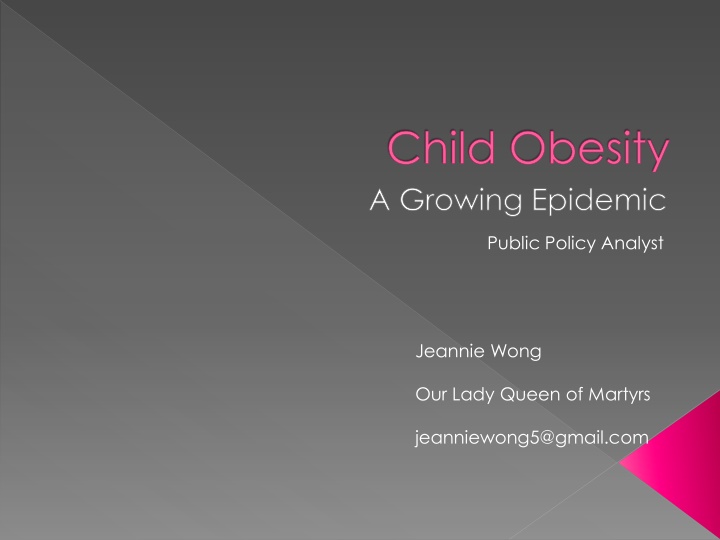
Child Obesity: Causes, Consequences, and Solutions
Explore the growing epidemic of child obesity, its causes, and health risks. Learn from Public Policy Analyst Jeannie Wong about tackling this issue through evidence-based policy solutions and promoting healthy habits. Watch informative videos and access resources for a comprehensive understanding of obesity in children.
Download Presentation

Please find below an Image/Link to download the presentation.
The content on the website is provided AS IS for your information and personal use only. It may not be sold, licensed, or shared on other websites without obtaining consent from the author. If you encounter any issues during the download, it is possible that the publisher has removed the file from their server.
You are allowed to download the files provided on this website for personal or commercial use, subject to the condition that they are used lawfully. All files are the property of their respective owners.
The content on the website is provided AS IS for your information and personal use only. It may not be sold, licensed, or shared on other websites without obtaining consent from the author.
E N D
Presentation Transcript
Child Obesity A Growing Epidemic Public Policy Analyst Jeannie Wong Our Lady Queen of Martyrs jeanniewong5@gmail.com
Which child do you think will run faster on a race? Turn and talk to your partners and explain.
Steps of the Public Policy Analyst Step 1: Define the Problem Step 2: Gather the Evidence Step 3: Identify the Causes Step 4: Examine an Existing Policy Step 5: Develop New Solutions Step 6: Select the Best Solution Feasibility vs. Effectiveness http://flippedtips.com/plegal/tips/welcome.html
What is Obesity? It is a medical condition in which too much body fat accumulates in the body and is stored there. Obesity and overweight are both terms used to label a weight that is greater than what is considered healthy. Obesity is linked to a number of health risks, including heart disease and diabetes.
Causes & Incidence Why are so many children obese in the USA? According to: *When children eat more than they need, their bodies store the extra calories in fat cells to use for energy later. If this pattern continues over time, and their bodies do not need this stored energy, they develop more fat cells and may develop obesity. www.ncbi.nlm.nih.gov/pubmedhealth
*Infants and young children are very good at listening to their bodies signals of hunger and fullness. They will stop eating as soon as their bodies tell them they have had enough. *But sometimes a parent tells them they have to finish everything on their plate. This forces them to ignore their fullness and eat everything that is served to them. *These learned habits lead to eating no matter if we are hungry or full. Many people have a very hard time breaking these habits.
Diabetes Obesity Heart disease Overweight High blood pressure Let s watch a video to be more aware of this disorder. http://www.cbsnews.com/video/watch/?id=682161n
What are some of the reasons for this disease? 1.) Junk Food 2.) _____________________ 3.) _____________________ 4.) _____________________ The children will define obesity using: http://flippedtips.com/plegal/tips/worksheet1.html
*What emotional problems arise from childhood obesity? http://www.cdc.gov/healthyyouth/obesity/facts.htm http://www2.aap.org/obesity/SoundAdvice/audio/Hassink/HassinkCom plete.mp3 http://mollenfoundation.org/2011/04/childhood-obesity-emotional- effects-and-sedentary-lifestyles/ http://www.betterhealth.vic.gov.au/bhcv2/bhcarticles.nsf/pages/Obes ity_in_children
Conditions that result from OBESITY The children will complete: http://flippedtips.com/plegal/tips/worksheet2.html
Child Obesity Facts *Childhood obesity has more than doubled in the past 30 years. *The percentage of children aged 6 11 years increased from 7% in 1980 to nearly 18% in 2010. *The percentage of adolescents aged 12 19 years who were obese increased from 5% to 18% over the same period. *In 2010, more than one third of children and adolescents were overweight or obese.
The children will work on: http://flippedtips.com/plegal/tips/worksheet3.html
Youth in America today lack regular physical exercise Including: Running Swimming Walking Bike riding Jumping rope Weight training Playing sports
Poor Nutrition Habits also contributes to the problem of OBESITY Including: Eating Fast Foods Fried Foods Diet High In Salt High Amounts of Sugar High Fructose Corn Syrup Trans Fat Over Eating Not eating regularly 3x s a day
http://3.bp.blogspot.com/-UrckpPFvNlo/UE1gjwbOgJI/AAAAAAAAAJc/3H94jzEQq8o/s1600/obesity+%25281%2529.jpghttp://3.bp.blogspot.com/-UrckpPFvNlo/UE1gjwbOgJI/AAAAAAAAAJc/3H94jzEQq8o/s1600/obesity+%25281%2529.jpg The students will work on: http://flippedtips.com/plegal/tips/existing.html
Existing Policies on Obesity What are some actions taken in the prevention of childhood obesity? http://www.ncsl.org/issues- research/health/childhood-obesity-2005- policy-options-nutrition.aspx http://www.obesitycampaign.org/ http://www.letsmove.gov/about
What are the best ways to deal with this issue? Based on the information you just learned, what are some things we can do to be more aware of the foods we eat and have a more active life style? Answer this question by doing the following: *Create an educational poster that highlights what you can do to live a healthier life style and the benefits of such a life style.
